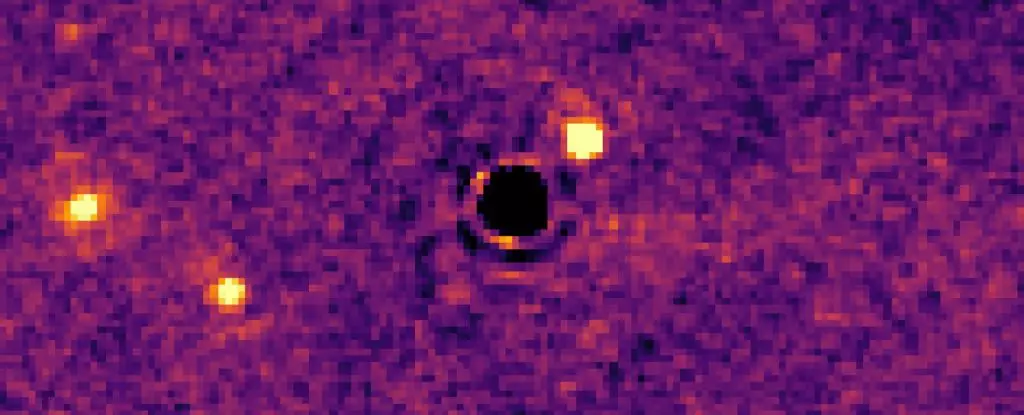The James Webb Space Telescope (JWST) is redefining the boundaries of our understanding of the cosmos, promising to unveil secrets that have long eluded astronomers. In its latest spectacular achievement, the JWST has directly imaged its first exoplanet, named TWA-7b. Located a mere 111 light-years away from Earth, TWA-7b represents a groundbreaking leap in exoplanet research. As the smallest world ever directly captured by a telescope, it opens a new chapter in how astronomers discern and study celestial bodies beyond our solar system.
What makes this discovery particularly profound is TWA-7b’s nature as a cold gas giant. With a mass approximately one-third that of Jupiter, this planet orbits a red dwarf star at a staggering distance—52 times that of Earth from our Sun. This placement positions TWA-7b reminiscent of our Kuiper Belt, far beyond Pluto, presenting the first clear view of a planet nestled in such inhospitable and distant conditions. The implications of this discovery stretch far beyond the immediate findings; they anchor themselves in the very fundamentals of planetary formation and evolution.
A Deep Dive into Planetary Formation Theories
The painstaking observations conducted by astronomers, notably a team led by Anne-Marie Lagrange from the Paris Observatory, revealed more than just a planet; they provided critical confirmations of existing theories regarding how celestial bodies form. Traditionally, scientists developed models suggesting that planets emerge from the accretion of material in disk-like structures surrounding young stars. TWA-7, at a youthful 6.4 million years, is still encircled by such material, creating both a unique opportunity for study and a living laboratory for verifying predictive models of planetary formation.
The team’s findings suggest that gaps seen in these protoplanetary disks—characteristic of newly forming planets—indicate a nesting ground for future worlds. They indicate that TWA-7b likely carved its own niche within its surrounding materials, akin to how shepherd moons maintain the structure of Saturn’s own rings. The researchers note an important caveat: while these gaps provide indirect evidence of forming bodies, no particular planet has yet been identified responsible for such structures. The ability to witness this process in real time could potentially revolutionize our understanding of planet formation across various stellar environments.
Implications Beyond the Discoveries
The significance of directly imaging TWA-7b goes well beyond this singular achievement. The JWST’s Mid-Infrared Instrument (MIRI) has opened a new frontier for identifying low-mass exoplanets, something previously believed to be at the leading edge of our observational capabilities. With TWA-7b weighing in at approximately 100 times the mass of Earth, this discovery not only extends the known lower limits for direct imaging but also encourages speculation that other even smaller worlds could lie undetected in the cosmos, waiting for us to find them.
Given that nearly 6,000 exoplanets have been confirmed to date, and only a fraction—around 80—have been directly visualized, the ramifications of the JWST findings are profound. The telescope’s capacity to explore exoplanet atmospheres through the analysis of starlight is significantly enhanced through direct imaging. This dual methodology enriches our understanding, revealing detailed and otherwise obscured characteristics of distant worlds.
The Path Ahead: Future Observations and Theoretical Models
The community of astronomers surrounding this discovery is optimistic about further investigation into TWA-7b. Observations suggest that this cold gas giant is a stellar candidate for intricate explorations into the interactions between developing planets and their respective environments. What remains tantalizingly enigmatic is the potential for JWST to unveil particulars about a more extensive class of exoplanets, possibly identifying worlds that have not been noticeable through previous methods.
With TWA-7b under the telescope’s keen scrutiny, future studies could afford deeper insights into questions about atmospheric compositions and the potential for habitability in exoplanets of various types. Given that the mechanisms of planetary evolution are complex and nuanced, continued observational data may unlock ways to synthesize theory with empirical findings, painting a fuller picture of our galactic neighbors.
The journey of TWA-7b marks only the beginning of a much larger quest, one poised to transform our comprehension of planetary systems throughout the universe. As advancements in technology and methodologies progress, so too will our ability to interpret the complex tapestries of stars and planets that illuminate our night sky.

